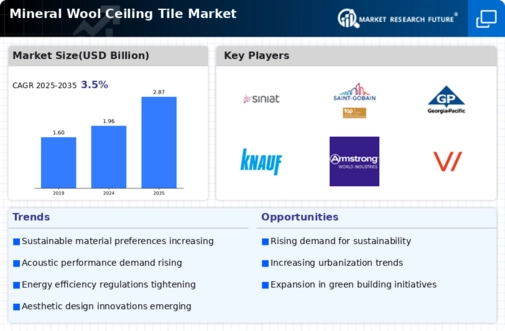Rising Construction Activities
The Global Mineral Wool Ceiling Tile Market Industry benefits from the ongoing rise in construction activities across various sectors. Urbanization and population growth drive the demand for residential, commercial, and industrial buildings. Governments worldwide are investing heavily in infrastructure development, which further fuels the need for effective building materials. Mineral wool ceiling tiles, with their fire-resistant and sound-absorbing qualities, are increasingly utilized in new constructions and renovations. This trend is expected to contribute to the market's growth, with projections indicating a market value of 2.87 USD Billion by 2035. As construction activities continue to thrive, the Global Mineral Wool Ceiling Tile Market Industry is poised for sustained expansion.
Increased Awareness of Acoustic Comfort
Increased awareness of acoustic comfort in building design significantly influences the Global Mineral Wool Ceiling Tile Market Industry. As urban environments become noisier, the demand for soundproofing solutions rises. Mineral wool ceiling tiles are recognized for their superior sound absorption capabilities, making them a preferred choice in various applications, including offices, schools, and healthcare facilities. This heightened focus on acoustic comfort is driving architects and designers to specify mineral wool products in their projects. As a result, the market is expected to grow steadily, with stakeholders increasingly recognizing the value of acoustic performance in enhancing occupant well-being. The Global Mineral Wool Ceiling Tile Market Industry is likely to see sustained growth as awareness continues to expand.
Regulatory Support for Energy Efficiency
Regulatory support for energy efficiency initiatives plays a crucial role in shaping the Global Mineral Wool Ceiling Tile Market Industry. Governments are implementing policies and standards that encourage the use of energy-efficient materials in construction. Mineral wool ceiling tiles, recognized for their thermal insulation properties, align well with these regulations. As building codes evolve to prioritize energy efficiency, the demand for mineral wool products is likely to increase. This regulatory environment not only promotes sustainable practices but also enhances the market's growth potential. The Global Mineral Wool Ceiling Tile Market Industry stands to benefit from these supportive measures, fostering a favorable landscape for manufacturers and consumers alike.
Technological Advancements in Manufacturing
Technological advancements in the manufacturing processes of mineral wool ceiling tiles significantly impact the Global Mineral Wool Ceiling Tile Market Industry. Innovations such as improved production techniques and enhanced material formulations lead to higher quality products that meet evolving consumer demands. These advancements not only enhance the performance characteristics of mineral wool tiles but also reduce production costs, making them more competitive in the market. As manufacturers adopt cutting-edge technologies, the industry is likely to witness increased efficiency and product diversity. This evolution may contribute to a compound annual growth rate (CAGR) of 3.52% from 2025 to 2035, indicating a robust future for the Global Mineral Wool Ceiling Tile Market Industry.
Growing Demand for Sustainable Building Materials
The Global Mineral Wool Ceiling Tile Market Industry experiences a notable surge in demand for sustainable building materials. As environmental concerns escalate, architects and builders increasingly favor materials that offer energy efficiency and sustainability. Mineral wool, known for its excellent thermal and acoustic insulation properties, aligns with these preferences. This trend is particularly pronounced in regions with stringent building regulations aimed at reducing carbon footprints. The market is projected to reach 1.96 USD Billion in 2024, reflecting a growing inclination towards eco-friendly construction practices. Consequently, the Global Mineral Wool Ceiling Tile Market Industry is likely to expand as more stakeholders prioritize sustainability in their projects.










